China's Economic Growth: Factors, Impacts, and Future Prospects
VerifiedAdded on 2022/08/13
|7
|2055
|17
Report
AI Summary
This report provides a comprehensive analysis of China's economic growth since 1978, examining the key factors that have driven its remarkable transformation. The study highlights the role of market-oriented reforms, high savings rates, and a large labor force in fueling GDP growth. It also explores the impact of domestic demand and the country's ability to finance its development independently. The report discusses the positive consequences of economic growth, such as poverty reduction and improved living standards, while also addressing the increasing income inequality. Furthermore, it touches upon the shift in the workforce, urbanization, and the rise of exports. The report concludes by emphasizing the lessons other countries can learn from China's economic development and its implications for the future.
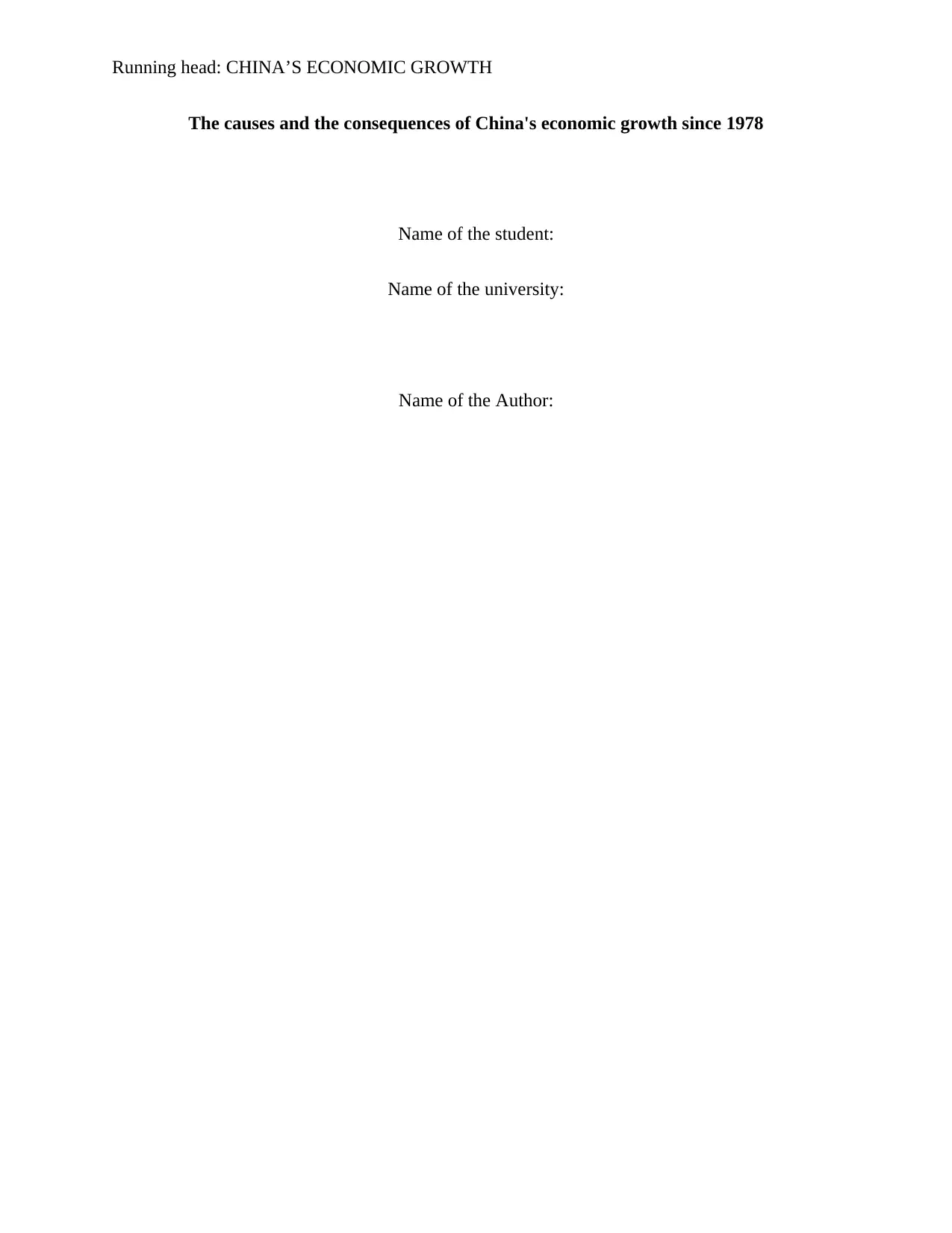
Running head: CHINA’S ECONOMIC GROWTH
The causes and the consequences of China's economic growth since 1978
Name of the student:
Name of the university:
Name of the Author:
The causes and the consequences of China's economic growth since 1978
Name of the student:
Name of the university:
Name of the Author:
Paraphrase This Document
Need a fresh take? Get an instant paraphrase of this document with our AI Paraphraser
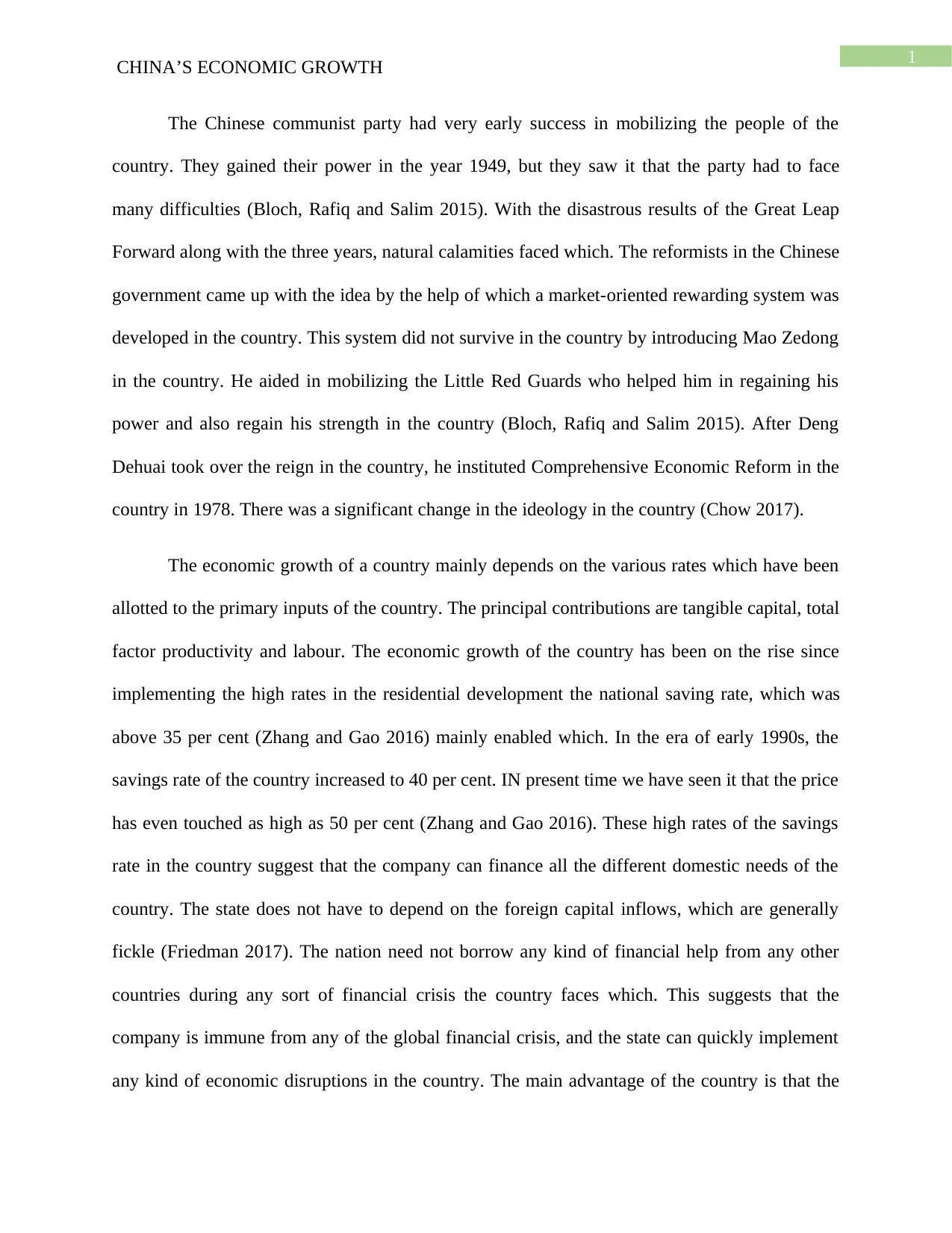
1
CHINA’S ECONOMIC GROWTH
The Chinese communist party had very early success in mobilizing the people of the
country. They gained their power in the year 1949, but they saw it that the party had to face
many difficulties (Bloch, Rafiq and Salim 2015). With the disastrous results of the Great Leap
Forward along with the three years, natural calamities faced which. The reformists in the Chinese
government came up with the idea by the help of which a market-oriented rewarding system was
developed in the country. This system did not survive in the country by introducing Mao Zedong
in the country. He aided in mobilizing the Little Red Guards who helped him in regaining his
power and also regain his strength in the country (Bloch, Rafiq and Salim 2015). After Deng
Dehuai took over the reign in the country, he instituted Comprehensive Economic Reform in the
country in 1978. There was a significant change in the ideology in the country (Chow 2017).
The economic growth of a country mainly depends on the various rates which have been
allotted to the primary inputs of the country. The principal contributions are tangible capital, total
factor productivity and labour. The economic growth of the country has been on the rise since
implementing the high rates in the residential development the national saving rate, which was
above 35 per cent (Zhang and Gao 2016) mainly enabled which. In the era of early 1990s, the
savings rate of the country increased to 40 per cent. IN present time we have seen it that the price
has even touched as high as 50 per cent (Zhang and Gao 2016). These high rates of the savings
rate in the country suggest that the company can finance all the different domestic needs of the
country. The state does not have to depend on the foreign capital inflows, which are generally
fickle (Friedman 2017). The nation need not borrow any kind of financial help from any other
countries during any sort of financial crisis the country faces which. This suggests that the
company is immune from any of the global financial crisis, and the state can quickly implement
any kind of economic disruptions in the country. The main advantage of the country is that the
CHINA’S ECONOMIC GROWTH
The Chinese communist party had very early success in mobilizing the people of the
country. They gained their power in the year 1949, but they saw it that the party had to face
many difficulties (Bloch, Rafiq and Salim 2015). With the disastrous results of the Great Leap
Forward along with the three years, natural calamities faced which. The reformists in the Chinese
government came up with the idea by the help of which a market-oriented rewarding system was
developed in the country. This system did not survive in the country by introducing Mao Zedong
in the country. He aided in mobilizing the Little Red Guards who helped him in regaining his
power and also regain his strength in the country (Bloch, Rafiq and Salim 2015). After Deng
Dehuai took over the reign in the country, he instituted Comprehensive Economic Reform in the
country in 1978. There was a significant change in the ideology in the country (Chow 2017).
The economic growth of a country mainly depends on the various rates which have been
allotted to the primary inputs of the country. The principal contributions are tangible capital, total
factor productivity and labour. The economic growth of the country has been on the rise since
implementing the high rates in the residential development the national saving rate, which was
above 35 per cent (Zhang and Gao 2016) mainly enabled which. In the era of early 1990s, the
savings rate of the country increased to 40 per cent. IN present time we have seen it that the price
has even touched as high as 50 per cent (Zhang and Gao 2016). These high rates of the savings
rate in the country suggest that the company can finance all the different domestic needs of the
country. The state does not have to depend on the foreign capital inflows, which are generally
fickle (Friedman 2017). The nation need not borrow any kind of financial help from any other
countries during any sort of financial crisis the country faces which. This suggests that the
company is immune from any of the global financial crisis, and the state can quickly implement
any kind of economic disruptions in the country. The main advantage of the country is that the
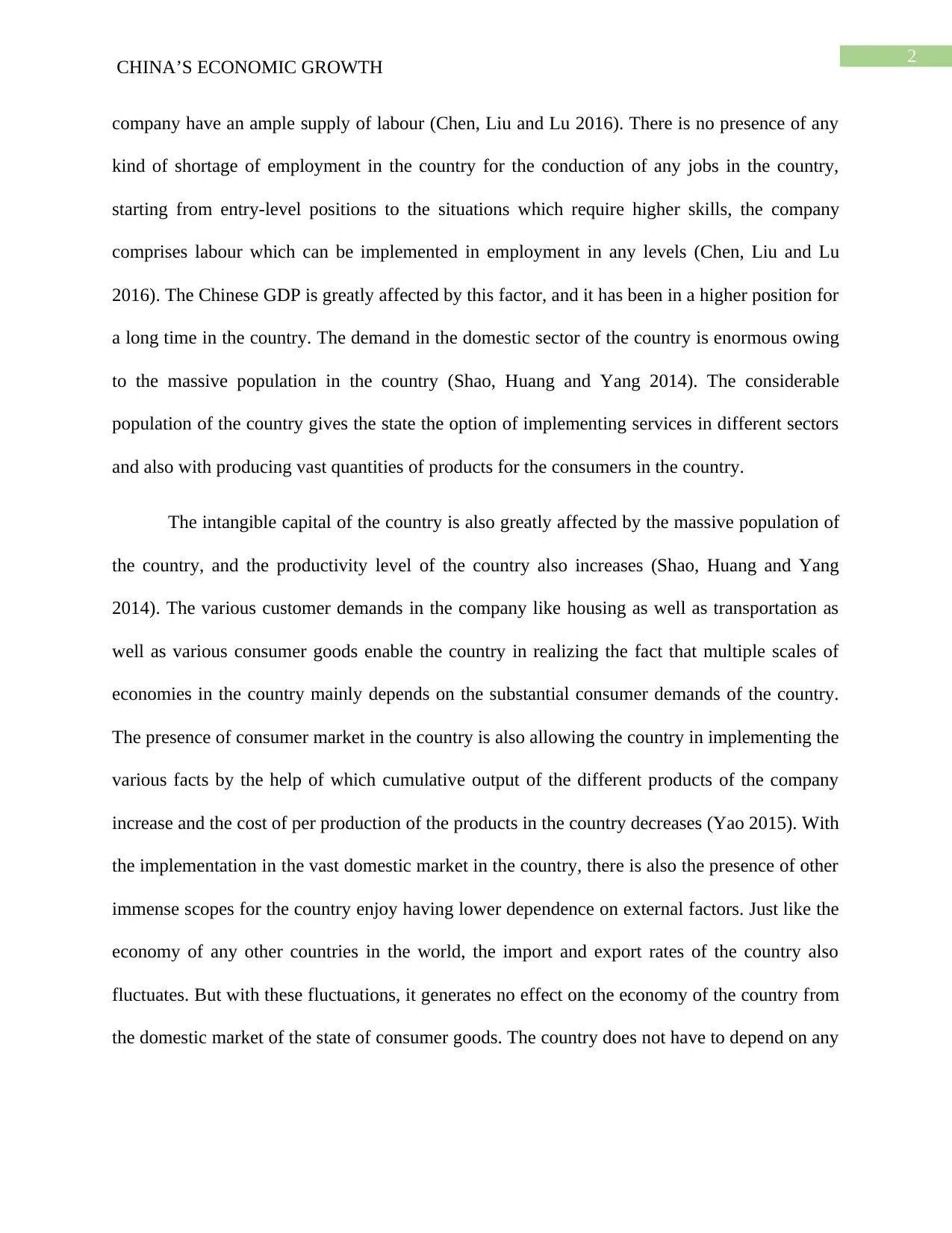
2
CHINA’S ECONOMIC GROWTH
company have an ample supply of labour (Chen, Liu and Lu 2016). There is no presence of any
kind of shortage of employment in the country for the conduction of any jobs in the country,
starting from entry-level positions to the situations which require higher skills, the company
comprises labour which can be implemented in employment in any levels (Chen, Liu and Lu
2016). The Chinese GDP is greatly affected by this factor, and it has been in a higher position for
a long time in the country. The demand in the domestic sector of the country is enormous owing
to the massive population in the country (Shao, Huang and Yang 2014). The considerable
population of the country gives the state the option of implementing services in different sectors
and also with producing vast quantities of products for the consumers in the country.
The intangible capital of the country is also greatly affected by the massive population of
the country, and the productivity level of the country also increases (Shao, Huang and Yang
2014). The various customer demands in the company like housing as well as transportation as
well as various consumer goods enable the country in realizing the fact that multiple scales of
economies in the country mainly depends on the substantial consumer demands of the country.
The presence of consumer market in the country is also allowing the country in implementing the
various facts by the help of which cumulative output of the different products of the company
increase and the cost of per production of the products in the country decreases (Yao 2015). With
the implementation in the vast domestic market in the country, there is also the presence of other
immense scopes for the country enjoy having lower dependence on external factors. Just like the
economy of any other countries in the world, the import and export rates of the country also
fluctuates. But with these fluctuations, it generates no effect on the economy of the country from
the domestic market of the state of consumer goods. The country does not have to depend on any
CHINA’S ECONOMIC GROWTH
company have an ample supply of labour (Chen, Liu and Lu 2016). There is no presence of any
kind of shortage of employment in the country for the conduction of any jobs in the country,
starting from entry-level positions to the situations which require higher skills, the company
comprises labour which can be implemented in employment in any levels (Chen, Liu and Lu
2016). The Chinese GDP is greatly affected by this factor, and it has been in a higher position for
a long time in the country. The demand in the domestic sector of the country is enormous owing
to the massive population in the country (Shao, Huang and Yang 2014). The considerable
population of the country gives the state the option of implementing services in different sectors
and also with producing vast quantities of products for the consumers in the country.
The intangible capital of the country is also greatly affected by the massive population of
the country, and the productivity level of the country also increases (Shao, Huang and Yang
2014). The various customer demands in the company like housing as well as transportation as
well as various consumer goods enable the country in realizing the fact that multiple scales of
economies in the country mainly depends on the substantial consumer demands of the country.
The presence of consumer market in the country is also allowing the country in implementing the
various facts by the help of which cumulative output of the different products of the company
increase and the cost of per production of the products in the country decreases (Yao 2015). With
the implementation in the vast domestic market in the country, there is also the presence of other
immense scopes for the country enjoy having lower dependence on external factors. Just like the
economy of any other countries in the world, the import and export rates of the country also
fluctuates. But with these fluctuations, it generates no effect on the economy of the country from
the domestic market of the state of consumer goods. The country does not have to depend on any
⊘ This is a preview!⊘
Do you want full access?
Subscribe today to unlock all pages.

Trusted by 1+ million students worldwide
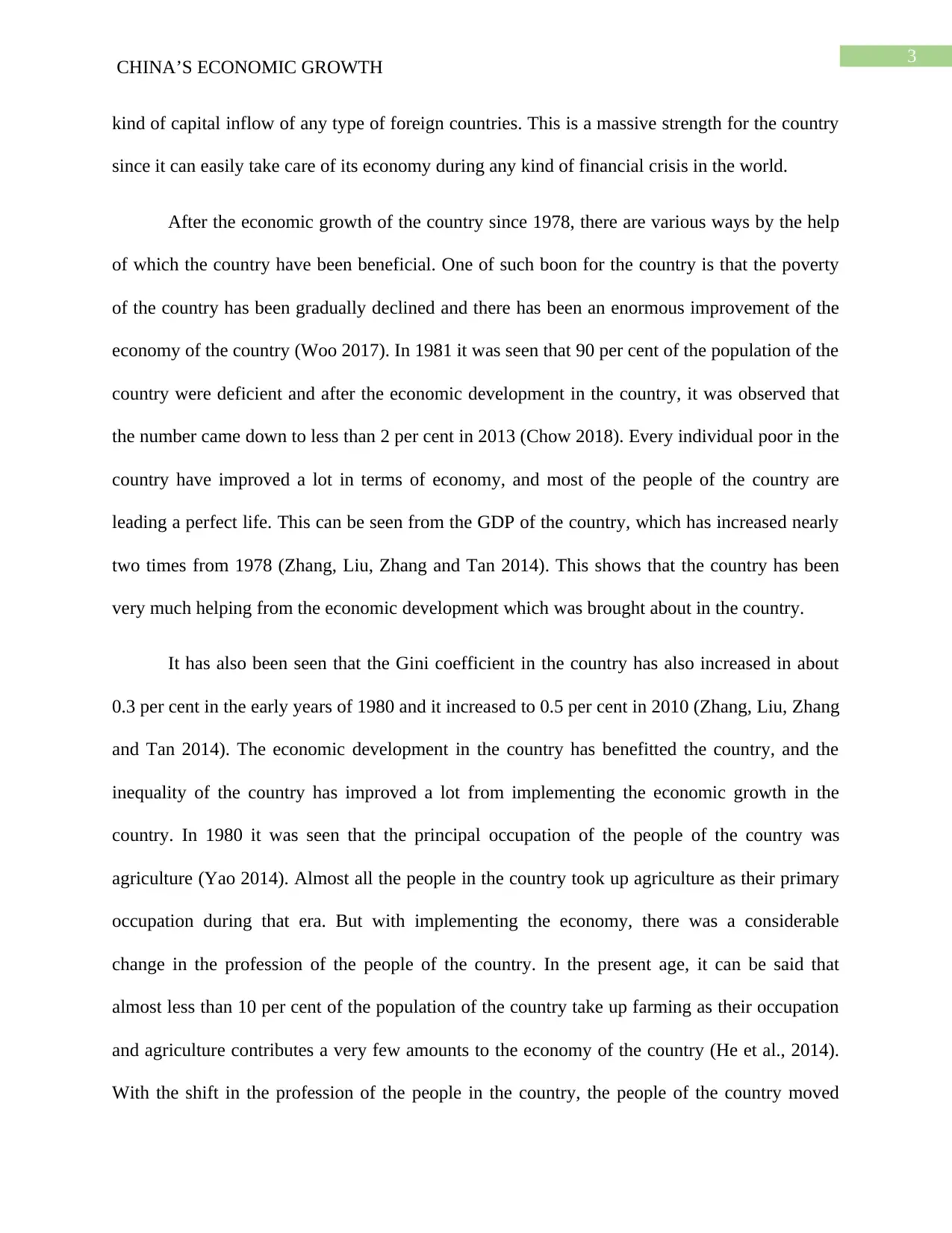
3
CHINA’S ECONOMIC GROWTH
kind of capital inflow of any type of foreign countries. This is a massive strength for the country
since it can easily take care of its economy during any kind of financial crisis in the world.
After the economic growth of the country since 1978, there are various ways by the help
of which the country have been beneficial. One of such boon for the country is that the poverty
of the country has been gradually declined and there has been an enormous improvement of the
economy of the country (Woo 2017). In 1981 it was seen that 90 per cent of the population of the
country were deficient and after the economic development in the country, it was observed that
the number came down to less than 2 per cent in 2013 (Chow 2018). Every individual poor in the
country have improved a lot in terms of economy, and most of the people of the country are
leading a perfect life. This can be seen from the GDP of the country, which has increased nearly
two times from 1978 (Zhang, Liu, Zhang and Tan 2014). This shows that the country has been
very much helping from the economic development which was brought about in the country.
It has also been seen that the Gini coefficient in the country has also increased in about
0.3 per cent in the early years of 1980 and it increased to 0.5 per cent in 2010 (Zhang, Liu, Zhang
and Tan 2014). The economic development in the country has benefitted the country, and the
inequality of the country has improved a lot from implementing the economic growth in the
country. In 1980 it was seen that the principal occupation of the people of the country was
agriculture (Yao 2014). Almost all the people in the country took up agriculture as their primary
occupation during that era. But with implementing the economy, there was a considerable
change in the profession of the people of the country. In the present age, it can be said that
almost less than 10 per cent of the population of the country take up farming as their occupation
and agriculture contributes a very few amounts to the economy of the country (He et al., 2014).
With the shift in the profession of the people in the country, the people of the country moved
CHINA’S ECONOMIC GROWTH
kind of capital inflow of any type of foreign countries. This is a massive strength for the country
since it can easily take care of its economy during any kind of financial crisis in the world.
After the economic growth of the country since 1978, there are various ways by the help
of which the country have been beneficial. One of such boon for the country is that the poverty
of the country has been gradually declined and there has been an enormous improvement of the
economy of the country (Woo 2017). In 1981 it was seen that 90 per cent of the population of the
country were deficient and after the economic development in the country, it was observed that
the number came down to less than 2 per cent in 2013 (Chow 2018). Every individual poor in the
country have improved a lot in terms of economy, and most of the people of the country are
leading a perfect life. This can be seen from the GDP of the country, which has increased nearly
two times from 1978 (Zhang, Liu, Zhang and Tan 2014). This shows that the country has been
very much helping from the economic development which was brought about in the country.
It has also been seen that the Gini coefficient in the country has also increased in about
0.3 per cent in the early years of 1980 and it increased to 0.5 per cent in 2010 (Zhang, Liu, Zhang
and Tan 2014). The economic development in the country has benefitted the country, and the
inequality of the country has improved a lot from implementing the economic growth in the
country. In 1980 it was seen that the principal occupation of the people of the country was
agriculture (Yao 2014). Almost all the people in the country took up agriculture as their primary
occupation during that era. But with implementing the economy, there was a considerable
change in the profession of the people of the country. In the present age, it can be said that
almost less than 10 per cent of the population of the country take up farming as their occupation
and agriculture contributes a very few amounts to the economy of the country (He et al., 2014).
With the shift in the profession of the people in the country, the people of the country moved
Paraphrase This Document
Need a fresh take? Get an instant paraphrase of this document with our AI Paraphraser
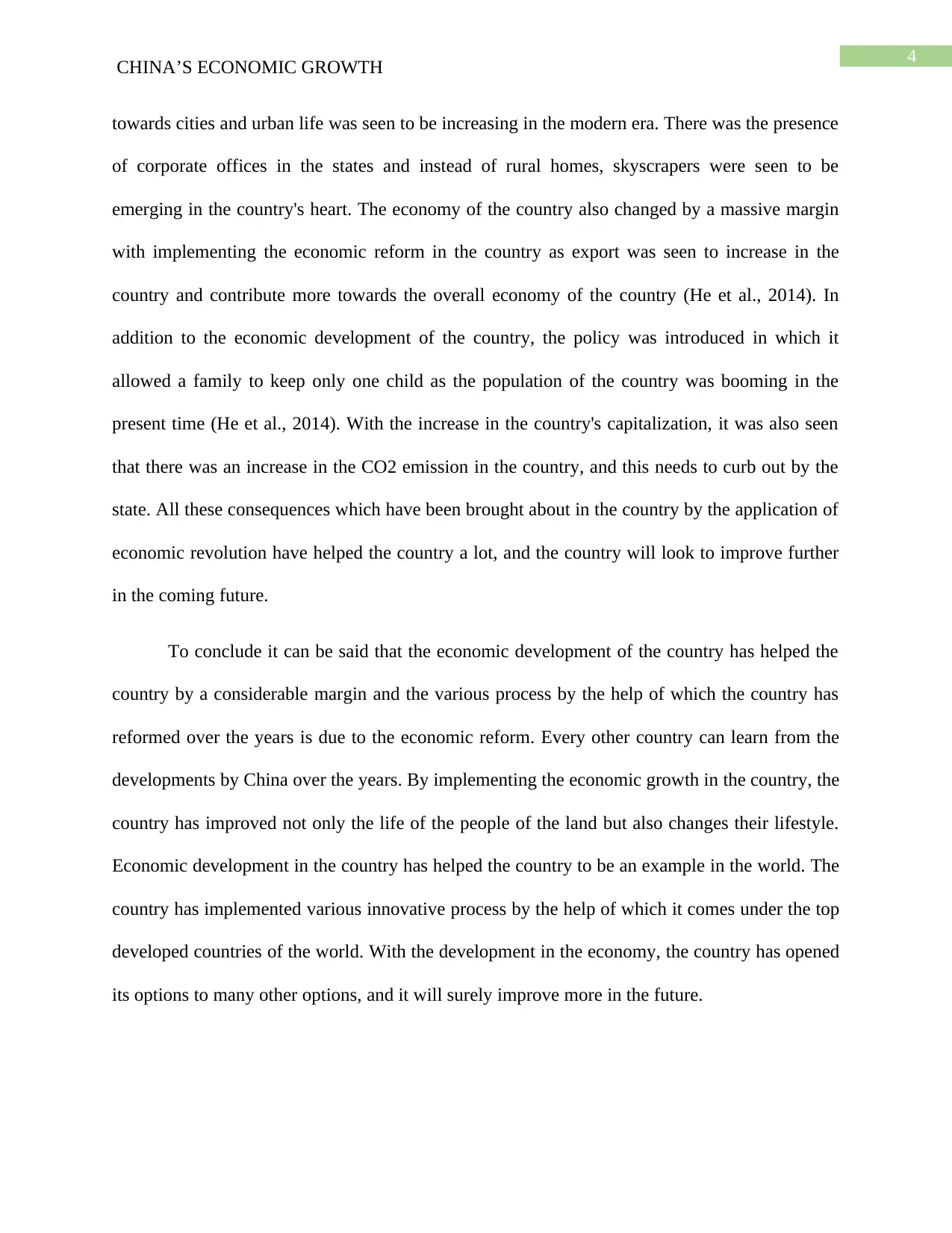
4
CHINA’S ECONOMIC GROWTH
towards cities and urban life was seen to be increasing in the modern era. There was the presence
of corporate offices in the states and instead of rural homes, skyscrapers were seen to be
emerging in the country's heart. The economy of the country also changed by a massive margin
with implementing the economic reform in the country as export was seen to increase in the
country and contribute more towards the overall economy of the country (He et al., 2014). In
addition to the economic development of the country, the policy was introduced in which it
allowed a family to keep only one child as the population of the country was booming in the
present time (He et al., 2014). With the increase in the country's capitalization, it was also seen
that there was an increase in the CO2 emission in the country, and this needs to curb out by the
state. All these consequences which have been brought about in the country by the application of
economic revolution have helped the country a lot, and the country will look to improve further
in the coming future.
To conclude it can be said that the economic development of the country has helped the
country by a considerable margin and the various process by the help of which the country has
reformed over the years is due to the economic reform. Every other country can learn from the
developments by China over the years. By implementing the economic growth in the country, the
country has improved not only the life of the people of the land but also changes their lifestyle.
Economic development in the country has helped the country to be an example in the world. The
country has implemented various innovative process by the help of which it comes under the top
developed countries of the world. With the development in the economy, the country has opened
its options to many other options, and it will surely improve more in the future.
CHINA’S ECONOMIC GROWTH
towards cities and urban life was seen to be increasing in the modern era. There was the presence
of corporate offices in the states and instead of rural homes, skyscrapers were seen to be
emerging in the country's heart. The economy of the country also changed by a massive margin
with implementing the economic reform in the country as export was seen to increase in the
country and contribute more towards the overall economy of the country (He et al., 2014). In
addition to the economic development of the country, the policy was introduced in which it
allowed a family to keep only one child as the population of the country was booming in the
present time (He et al., 2014). With the increase in the country's capitalization, it was also seen
that there was an increase in the CO2 emission in the country, and this needs to curb out by the
state. All these consequences which have been brought about in the country by the application of
economic revolution have helped the country a lot, and the country will look to improve further
in the coming future.
To conclude it can be said that the economic development of the country has helped the
country by a considerable margin and the various process by the help of which the country has
reformed over the years is due to the economic reform. Every other country can learn from the
developments by China over the years. By implementing the economic growth in the country, the
country has improved not only the life of the people of the land but also changes their lifestyle.
Economic development in the country has helped the country to be an example in the world. The
country has implemented various innovative process by the help of which it comes under the top
developed countries of the world. With the development in the economy, the country has opened
its options to many other options, and it will surely improve more in the future.
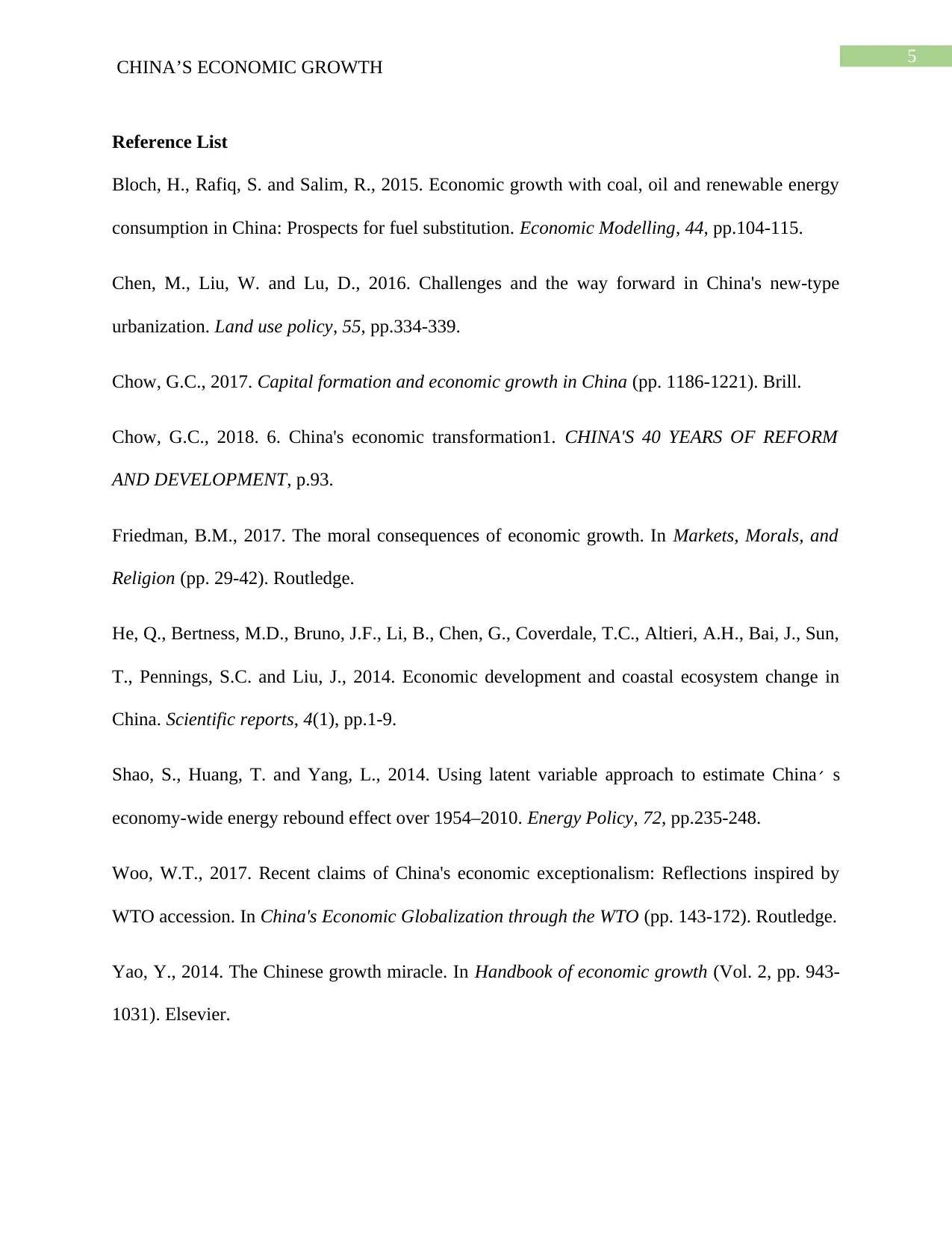
5
CHINA’S ECONOMIC GROWTH
Reference List
Bloch, H., Rafiq, S. and Salim, R., 2015. Economic growth with coal, oil and renewable energy
consumption in China: Prospects for fuel substitution. Economic Modelling, 44, pp.104-115.
Chen, M., Liu, W. and Lu, D., 2016. Challenges and the way forward in China's new-type
urbanization. Land use policy, 55, pp.334-339.
Chow, G.C., 2017. Capital formation and economic growth in China (pp. 1186-1221). Brill.
Chow, G.C., 2018. 6. China's economic transformation1. CHINA'S 40 YEARS OF REFORM
AND DEVELOPMENT, p.93.
Friedman, B.M., 2017. The moral consequences of economic growth. In Markets, Morals, and
Religion (pp. 29-42). Routledge.
He, Q., Bertness, M.D., Bruno, J.F., Li, B., Chen, G., Coverdale, T.C., Altieri, A.H., Bai, J., Sun,
T., Pennings, S.C. and Liu, J., 2014. Economic development and coastal ecosystem change in
China. Scientific reports, 4(1), pp.1-9.
Shao, S., Huang, T. and Yang, L., 2014. Using latent variable approach to estimate China׳ s
economy-wide energy rebound effect over 1954–2010. Energy Policy, 72, pp.235-248.
Woo, W.T., 2017. Recent claims of China's economic exceptionalism: Reflections inspired by
WTO accession. In China's Economic Globalization through the WTO (pp. 143-172). Routledge.
Yao, Y., 2014. The Chinese growth miracle. In Handbook of economic growth (Vol. 2, pp. 943-
1031). Elsevier.
CHINA’S ECONOMIC GROWTH
Reference List
Bloch, H., Rafiq, S. and Salim, R., 2015. Economic growth with coal, oil and renewable energy
consumption in China: Prospects for fuel substitution. Economic Modelling, 44, pp.104-115.
Chen, M., Liu, W. and Lu, D., 2016. Challenges and the way forward in China's new-type
urbanization. Land use policy, 55, pp.334-339.
Chow, G.C., 2017. Capital formation and economic growth in China (pp. 1186-1221). Brill.
Chow, G.C., 2018. 6. China's economic transformation1. CHINA'S 40 YEARS OF REFORM
AND DEVELOPMENT, p.93.
Friedman, B.M., 2017. The moral consequences of economic growth. In Markets, Morals, and
Religion (pp. 29-42). Routledge.
He, Q., Bertness, M.D., Bruno, J.F., Li, B., Chen, G., Coverdale, T.C., Altieri, A.H., Bai, J., Sun,
T., Pennings, S.C. and Liu, J., 2014. Economic development and coastal ecosystem change in
China. Scientific reports, 4(1), pp.1-9.
Shao, S., Huang, T. and Yang, L., 2014. Using latent variable approach to estimate China׳ s
economy-wide energy rebound effect over 1954–2010. Energy Policy, 72, pp.235-248.
Woo, W.T., 2017. Recent claims of China's economic exceptionalism: Reflections inspired by
WTO accession. In China's Economic Globalization through the WTO (pp. 143-172). Routledge.
Yao, Y., 2014. The Chinese growth miracle. In Handbook of economic growth (Vol. 2, pp. 943-
1031). Elsevier.
⊘ This is a preview!⊘
Do you want full access?
Subscribe today to unlock all pages.

Trusted by 1+ million students worldwide
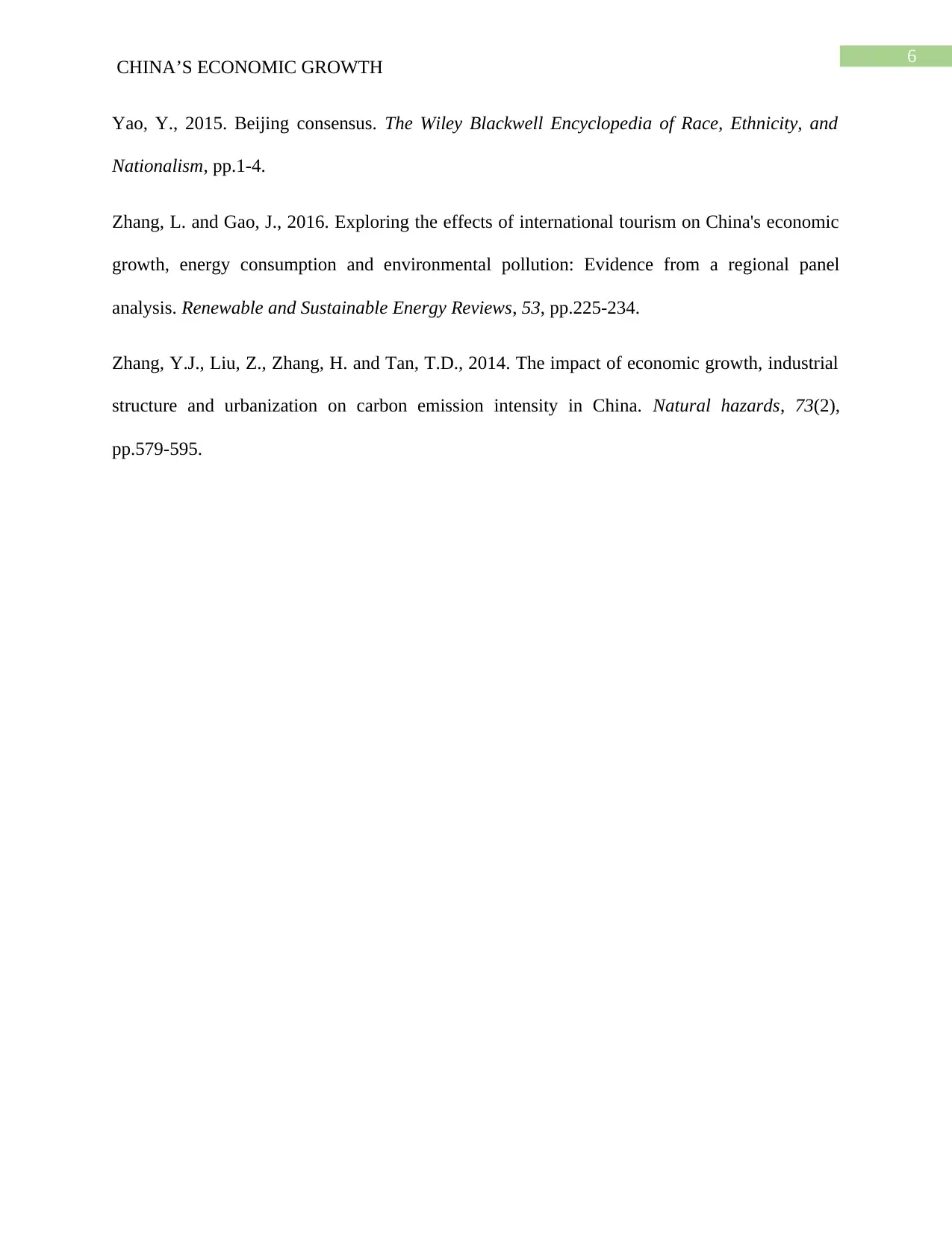
6
CHINA’S ECONOMIC GROWTH
Yao, Y., 2015. Beijing consensus. The Wiley Blackwell Encyclopedia of Race, Ethnicity, and
Nationalism, pp.1-4.
Zhang, L. and Gao, J., 2016. Exploring the effects of international tourism on China's economic
growth, energy consumption and environmental pollution: Evidence from a regional panel
analysis. Renewable and Sustainable Energy Reviews, 53, pp.225-234.
Zhang, Y.J., Liu, Z., Zhang, H. and Tan, T.D., 2014. The impact of economic growth, industrial
structure and urbanization on carbon emission intensity in China. Natural hazards, 73(2),
pp.579-595.
CHINA’S ECONOMIC GROWTH
Yao, Y., 2015. Beijing consensus. The Wiley Blackwell Encyclopedia of Race, Ethnicity, and
Nationalism, pp.1-4.
Zhang, L. and Gao, J., 2016. Exploring the effects of international tourism on China's economic
growth, energy consumption and environmental pollution: Evidence from a regional panel
analysis. Renewable and Sustainable Energy Reviews, 53, pp.225-234.
Zhang, Y.J., Liu, Z., Zhang, H. and Tan, T.D., 2014. The impact of economic growth, industrial
structure and urbanization on carbon emission intensity in China. Natural hazards, 73(2),
pp.579-595.
1 out of 7
Your All-in-One AI-Powered Toolkit for Academic Success.
+13062052269
info@desklib.com
Available 24*7 on WhatsApp / Email
![[object Object]](/_next/static/media/star-bottom.7253800d.svg)
Unlock your academic potential
Copyright © 2020–2025 A2Z Services. All Rights Reserved. Developed and managed by ZUCOL.

